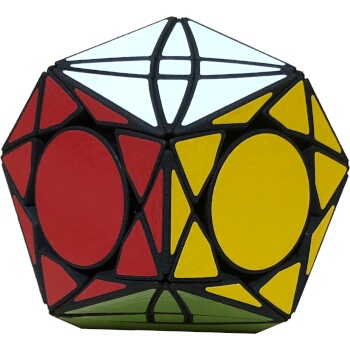
Above:View 1
Click a thumbnail to see its larger version and description.
The Tetragram with curvy cuts that make two types of pieces visible and one additional turn.
Tetragram II is a slightly deeper cut version of the Tetragram from the same inventor. The cuts have been curved to allow for new pieces in "rex cube" style to show up on the puzzle. Like the Tetragram, this puzzle turns on 4 axes of rotation, each capable of 180 degree turns. Additionally, a new turning axis has been introduced at the bottom face, which is capable of 90 degree turns. This new axis required the geometry to be fudged slightly (actually, a lot), which means that there are now gaps between the pieces and the central polygon is now a circle. The axis system can be viewed as an intersection of two equilateral triangles or some type of square pyramid.
Also like the Tetragram, this puzzle can jumble too, but one can only do a 7 turn sequence that brings it back to shape.
Despite the fudging, the puzzle is still quite stable. It has a rather strange feel when turning it due to the pieces wiggling slightly, but it only catches occasionally.
Edge length: 48 mm (squares)
The puzzle has 31345665638400000000 = 31.2*10^18 permutations if all pieces are considered distinguishable and if one assumes that the circles still count as pentagons.
Compared with the number available if the puzzle can be disassembled and reassembled there are these restrictions:
-The asymmetric edges are split into 4 sets.
-The combined permutation of the asymmetric edges is always even. (factor=2)
-The triangles are split into 4 sets.
-The first set of triangles determines the permutations of the last two triangles in the other three sets. (factor=8)
-The orientation of the last pentagon is determined by the other three. (factor=5)
-The new triangles (adjacent to the squares) are split into 4 sets.
-The parity of the symmetrical edges determine the parity of the last three sets of asymmetric edges. (factor=8)
-The parity of the symmetrical edges determine the parity of the last set of triangles. (factor=2)
-The parity of the symmetrical edges determine the parity of the pentagons. (factor=2)
-The parity of the symmetrical edges determine the parity of the squares. (factor=2)
-The parity of the symmetrical edges determine the parity of the last three sets of new triangles. (factor=8)
-The parity of the symmetrical edges and the overall parity of new triangles are identical. (factor=2)
Stickered as shown here the puzzle has 250765325107200000 = 251*10^15 permutations.
Links

Contributors
No one has contributed to this page yet!
Collections
This puzzle can be found in collections of these members:
Found a mistake or something missing?
Edit it yourself or
contact the moderator.









